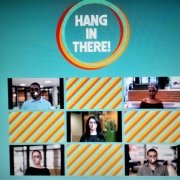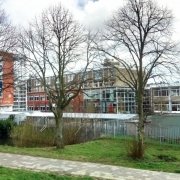Koplopers
Excerpt
This project addresses a diverse group of adolescents and young adults who experience thresholds in their lives and (education) careers, as well as in their environments (schools, universities, municipalities, etc.) due to psychological problems. Two universities, a group of (mostly) students, two large secondary vocational schools and several departments of the local government in Rotterdam are involved in this project, which aims to address and describe the problem “from within”, as well as come up with possible solutions and ideas. Psychological hindrances are increasingly in the spotlight in the Netherlands and it affects many in their performance, causing them not to reach their full potential. The problem is much bigger than one might expect and people (governments, policy makers, researchers, teachers etc.) are beginning to realize this. Many people and many kinds of psychological problems are involved, therefore the group of people suffering from these problems is also highly diverse. Think of attention disorders, over-stimulation, under-stimulation, social anxiety, low self-esteem, autism, (mild) depression, trauma, psychiatric disorders, etc.
Narrative, origins and objectives of the initiative
What kind of project is this? Please give a short description (summary) of it.
In The Netherlands, one of the municipalities’ tasks is to interpret and contribute to the idea of the so-called participatiesamenleving (literally: “participation society”), a society in which everyone, as a citizen, takes responsibility for themselves, others and the greater whole. Therefore, stimulating civilians to play a (pro)active role in society is one of the spearheads of the local governments’ policy. The underlying assumption is that most people are basically able to look after themselves, sometimes with support from their social environments (roughly translated from Dudevszky & Witte, 2017).[1]
Education and work are conditional for a citizen to be able to participate in society. Not everyone, though, is qualified to keep up with all the developments and society often lacks facilities to include people in unstable situations. Among these are young people (e.g. students in higher education), struggling with psychological obstacles in their daily lives. This project is about detecting the needs of these young people (aged 15-25 years) and the political challenges that municipalities have to deal with (Dudevszky & Witte, 2017).
For RUAS, the objective is to include students with psychological problems (e.g. depression, personality disorders, autism, trauma-related problems) in the educational system, instead of looking at them as being 'different'. Listening to these students and considering their needs and experiences must lead to a better sense of belonging, better performance and fewer dropouts.
[1] Dudevszki, S.I.Z.A. & Witte, G.T. (2017): Participatie en inclusie van jongeren met psychische kwetsbaarheid. Liefde moet van twee kanten komen. In: Jeugdbeleid 11:99-104. Bohn Stafleu van Loghum, 2017.
Please tell us why, in general, this project is considered a successful one?
This project seems to "hit the nail on the head". Everything comes together: (mental) health care (decentralization of tasks and responsibilities from national to local governments), adolescents suffering from psychological barriers, urban tertiary and secondary vocational educational organizations wanting to improve study success by offering a safer and more inclusive learning environment. A group of RUAS students had already asked for special attention for the problems they experienced during their study career due to a variety of personal and psychological problems.
And why would you consider it a grass-roots initiative?
A group of ‘experience expert’ HE-students (partly) initiated and adopted the project. Teachers, researchers and (municipal) civil servants are also involved. It seems that there was already a widespread feeling that something had to be done here, and now the project helps to detect and describe the problem, facilitating teachers and students to look at it more systematically, searching for working solutions and, very important, break the silence and communicate openly about topics like this. Nothing for us or about us, without us! Conclusion: this project is (partly) adopted and run by members of its target group.
What challenges needed to be solved in this project?
Creating more awareness, openness and better inclusion for students with psychological problems in educational organizations; to ensure that these students are better heard. Teachers, managers and other employees are addressed and stimulated to develop "antennas" in dealing with this specific target group. Moreover, institutional barriers can make it hard for individuals who are an exception to the rules to be who they are and, therefore, can block the way to genuine inclusion. The target group of students tend to show higher dropout rates; eventually, if they feel more at home, these rates are expected to improve.
Is this initiative based on any particular theoretical framework? Which one?
This project was not initially based on a particular kind of theoretical framework. Students, however, who share their knowledge and experience with municipalities, youth care organizations and schools use the Contact Strategy. Patrick W. Corrigan cs distinguished three strategies for changing stigmatizing attitudes about mental illnesses. One of them is the Contact Strategy, which challenges public attitudes about mental illness through direct interactions with persons who have these disorders.[1]
[1] Corrigan, P.W. L.; River, P; Lundin, R.K.; Penn, D.L.; Uphoff-Wasowski, K.; Campion, J.; Mathisen, J.; Gagnon, C.; Bergman, M.; Goldstein, H.; Kubiak, M.A.: Three Strategies for Changing Attributions about Severe Mental Illness. Schizophrenia Bulletin, Volume 27, Issue 2, 1 January 2001, Pages 187–195, https://doi.org/10.1093/oxfordjournals.schbul.a006865
(Appendix) Is your intervention standing on its own or is it a part of a bigger and more holistic approach?
‘Koplopers’ is part of Rotterdamse Werkplaats ST-RAW and Werkplaats Sociaal Domein Zuid-Holland Zuid. These academic labs aim to connect practice, governance, research and education in order to find innovative solutions for regional problems in the social sector.
Please describe the group(s) intended as beneficiaries of this initiative
Why has this group (have these groups) been chosen?
The target group is adolescents or students suffering from personal and/or psychological problems that hinder their study career and their participation as a citizen in society. These students tend to show higher dropout rates. This group has been chosen because the problem is much bigger than most people realize. Many people (also students) feel uncomfortable because of psychological problems; their problems can be the reason why they are less successful. They often feel that they are not fully understood, over-stimulated, exceptionally difficult (in the eyes of their peers and teachers), etc. (See also the excerpt about the Participatiesamenleving; “Participation Society”.)
Could you please tell us something about the relative size of the (of each) target group, within the school/university population, region and/or country?
Research shows that about 20% of the adult population suffers from a certain degree of psychological problems that can hinder their prospective in life (career etc.). There is no reason to believe that the same doesn’t go for students. The municipality of Rotterdam estimates that the city counts about 30.000 sensitive juveniles, 7.000 of which are considered to form a ‘high-risk group’; an unknown percentage of both groups having (also) psychological problems. For RUAS, it is estimated (in a survey) that 7,1% of their population suffers from psychological problems (approximately 2.500 students). These students tend to have a higher risk of dropout, have more difficulties finding an internship or a job, postpone more, etc. https://profielen.hr.nl/2016/het-grote-hr-ongeluksonderzoek/
Which social characteristics are taken into account and what is the geographical area covered?
These students tend to have a higher risk of dropout, have more difficulties finding an internship or a job, postpone more, etc.
https://profielen.hr.nl/2016/het-grote-hr-ongeluksonderzoek/
On which level is the project implemented?
Implemented / focus on RUAS level.
Please describe the political and socio-economic factors that you believe have been important enablers for your initiative
Did the initiative have political support?
The boards of the participating schools also support this initiative. In 2016, Profielen, the independent online magazine of RUAS, published a comparative study about the sense of happiness among students at all university departments.[1] This was one of the main initiators of Koplopers.
Powerplatform, a platform run by and aimed at students with disabilities and the deans of RUAS, also supported the project.
[1] Source (Dutch): Het grote HR (on)geluksonderzoek, Profielen, 20 September 2016: https://profielen.hr.nl/wp-content/uploads/profielen131.pdf
How did it fit with local, regional or national policies?
Clearly, this kind of initiative is supported by national and local governments. As already described, the municipality of Rotterdam is also involved in this project, translating national principles (“participation society”) into local politics and trying to create a ‘fall back’ for people that are not-so-self-supporting.
Who are the stakeholders supporting the initiative?
As mentioned, researchers, students (from the target group), teachers and local civil servants are the main contributors to this project. ‘Koplopers’ is part of Rotterdamse Werkplaats ST-RAW and Werkplaats Sociaal Domein Zuid-Holland Zuid.
Are there particular demographic changes present that are influencing the project?
No, not during the project itself. As mentioned, this project was realized in a context of increasing awareness about this topic in society.
What is the institutional strategy and culture of the (educational) organization?
In August 2016, a new RUAS Strategic Agenda (https://rotterdamuas.com/globalassets/documenten/hogeschool/over-ons/our-agenda.pdf) and Educational Vision (https://hint.hr.nl/contentassets/69e15835803046739fadfed73d81bc71/vision-on-education.pdf) were introduced. The message is: RUAS wants to be at the heart of the (near) future developments in the region, helping a diverse student population to emancipate and obtain the knowledge, skills and attitude they need to be part of the 21st century society.
To what extent does the initiative have an influence on institutional policy (or potential influence) of the (educational) organization?
In addition to the answer to the above question: the project participants would like to aim at “overall inclusion in terms of a talent centered, tailor made, ‘universal design for learning’ kind of education.” This seems to be in line with the RUAS policy and by presenting itself at internal events (like the Infomarkt on 6 September 2018), the project representatives address their point of view.
(Appendix) Is there public support for your initiative and the issue it addresses?
As stated, the problem of psychological barriers is something that many in Dutch society became aware of lately, especially since some famous public figures (like a popular radio DJ suffering from depression) talked openly about their struggles in everyday life and, therewith, put the subject on the agenda.
(Appendix) What other factors do you think have been important for the success of this initiative?
Local media attention for the subject and the project can be seen as a factor. Apart from that: this project already has a certain amount of “fame” among students of the Social Work department at RUAS.
Please describe the overall initiative design and the methods and tools used to reach the goals
Please describe the specific activities carried out.
In order to create more awareness, openness and better inclusion for students with psychological problems in educational organizations, teachers, managers and other employees participated in several workshops and were trained to develop antennas in dealing with this specific target group. Also, a checklist of barriers and facilitators for participation of young people with mental disabilities has been developed.
Two broadcastings (at local radio stations) about the subject and the project created more awareness among a wider audience than RUAS.
Several studies were carried out to describe and detect the problem and to look at the problem in a more systematic way.[1] [2] Bachelor and Master students graduate on the subject.
Embedding the project findings and results in RUAS curricula, aimed to train future professionals in dealing with this specific target group. (Minor).[3]
[1] Dudevszky, S.I.Z.A. & Witte, T. (2017): Participatie en inclusie van jongeren met psychische kwetsbaarheid, 29 mei 2017. DOI 10.1007/s12451-017-0145-y
[2] Venema: Rotterdamse scholen zoeken hulp voor kwetsbare student. In: Algemeen Dagblad, 6 April 2017
[3] For an overall list of publications (in Dutch), see: https://www.zonmw.nl/nl/over-zonmw/onderwijs/programmas/project-detail/academische-werkplaatsen-transformatie-jeugd/koplopersparticipatie-van-jongeren-met-psychische-problemen/resultaten.
What were the key roles (teacher, student, management team etc.) within the project?
A group of ‘experience expert’ HE-students (partly) initiated and adopted the project. Following the Contact Strategy, they shared their knowledge and experiences with schools and local governmental organizations, and addressed stigmas and prejudices. Teachers, researchers and (municipal) civil servants were also involved. They helped to break the silence about these kind of topics and created spaces to communicate openly about it.
What ideas, tools, theories, models, methodology (etc.) have been used to reach the goals?
As described earlier, the Contact Strategy of Patrick W. Corrigan cs is used as a source of inspiration by the RUAS-students to communicate about their struggles and needs.
What are the final revenues of the project?
This project is only half-way, so there are no ‘final revenues’ yet.
Please describe if your project ensured its sustainability
If so, how did you ensure the short-term impact of the project?
Broadcastings, publications, research studies and workshops with teachers brought more awareness of the high rates of school dropouts among students with psychological problems and the need for a change in mindset of teachers towards students. "Early adopters" teachers develop "antennas" in dealing with the specific target group and learn how to create a more inclusive environment. They are (also) considered to be future ambassadors for the subject among their colleagues.
And how did you ensure the long-term impact of the project?
In line with the question about the short-term impact: by up-scaling, create ambassadors among teachers, students and other members of the university community and its context (including the partner organizations). Ideally, to ensure a long-term impact, it is important that the project is embedded in RUAS organization structures and is carried by experience experts.
Has your project been replicated elsewhere?
No.
Please tell us about the resources used in this initiative
What was the budget for the initiative?
ZonMw subsidized the Koplopers project with an amount of €200.000 for the total duration of three years (ZonMw is a Dutch “semi-government foundation” established in The Hague that funds research and innovation in healthcare and care.[1]
[1] General website (in Dutch): https://www.zonmw.nl/nl/
How much did the initiative depend on volunteers?
As already mentioned, this initiative depends partly on volunteers; the most important ones being active students at the universities and vocational schools who are willing to speak openly about the thresholds they have experienced in their lives and educational careers.
How were the costs perceived by the public/the sector/other stakeholders?
N.A.
To what extent did the initiative achieve its objectives?
Please describe the evidence to support the success of your initiative.
There are no final revenues since the project isn't complete yet, but it gets lot of attention from both students and teachers within RUAS, and from the local media.
Did the intervention lead to any unintended (positive) outcomes?
The intervention helps to bridge the gap between ‘research’ and ‘education’: (under)graduation students participate in lectorate expertise centers; educational products (like a minor on the topic) were developed in which findings from research are shared with the university community.
What indicators (quantitative and qualitative) have you measured to demonstrate success?
Surveys among students of the target group already show promising results.
(Appendix) How did you evaluate/monitor this intervention?
It was evaluated/monitored via the internal quality system of the Kennicentrum Talentontwikkeling and the RUAS dashboards.










